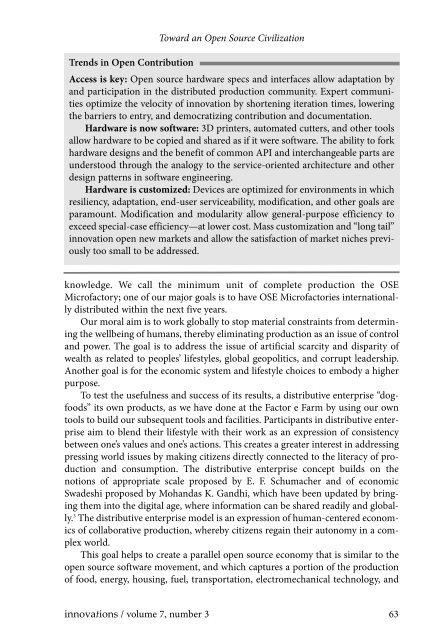Jakubowski-thomson
Jakubowski-thomson
Jakubowski-thomson
You also want an ePaper? Increase the reach of your titles
YUMPU automatically turns print PDFs into web optimized ePapers that Google loves.
Toward an Open Source Civilization<br />
Trends in Open Contribution<br />
Access is key: Open source hardware specs and interfaces allow adaptation by<br />
and participation in the distributed production community. Expert communities<br />
optimize the velocity of innovation by shortening iteration times, lowering<br />
the barriers to entry, and democratizing contribution and documentation.<br />
Hardware is now software: 3D printers, automated cutters, and other tools<br />
allow hardware to be copied and shared as if it were software. The ability to fork<br />
hardware designs and the benefit of common API and interchangeable parts are<br />
understood through the analogy to the service-oriented architecture and other<br />
design patterns in software engineering.<br />
Hardware is customized: Devices are optimized for environments in which<br />
resiliency, adaptation, end-user serviceability, modification, and other goals are<br />
paramount. Modification and modularity allow general-purpose efficiency to<br />
exceed special-case efficiency—at lower cost. Mass customization and “long tail”<br />
innovation open new markets and allow the satisfaction of market niches previously<br />
too small to be addressed.<br />
knowledge. We call the minimum unit of complete production the OSE<br />
Microfactory; one of our major goals is to have OSE Microfactories internationally<br />
distributed within the next five years.<br />
Our moral aim is to work globally to stop material constraints from determining<br />
the wellbeing of humans, thereby eliminating production as an issue of control<br />
and power. The goal is to address the issue of artificial scarcity and disparity of<br />
wealth as related to peoples’ lifestyles, global geopolitics, and corrupt leadership.<br />
Another goal is for the economic system and lifestyle choices to embody a higher<br />
purpose.<br />
To test the usefulness and success of its results, a distributive enterprise “dogfoods”<br />
its own products, as we have done at the Factor e Farm by using our own<br />
tools to build our subsequent tools and facilities. Participants in distributive enterprise<br />
aim to blend their lifestyle with their work as an expression of consistency<br />
between one’s values and one’s actions. This creates a greater interest in addressing<br />
pressing world issues by making citizens directly connected to the literacy of production<br />
and consumption. The distributive enterprise concept builds on the<br />
notions of appropriate scale proposed by E. F. Schumacher and of economic<br />
Swadeshi proposed by Mohandas K. Gandhi, which have been updated by bringing<br />
them into the digital age, where information can be shared readily and globally.<br />
3 The distributive enterprise model is an expression of human-centered economics<br />
of collaborative production, whereby citizens regain their autonomy in a complex<br />
world.<br />
This goal helps to create a parallel open source economy that is similar to the<br />
open source software movement, and which captures a portion of the production<br />
of food, energy, housing, fuel, transportation, electromechanical technology, and<br />
innovations / volume 7, number 3 63


